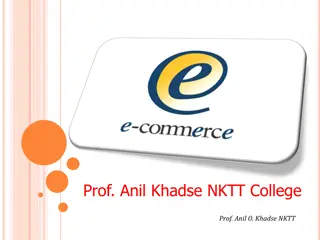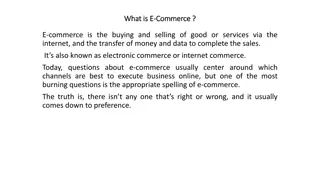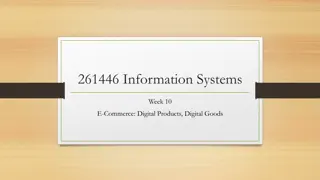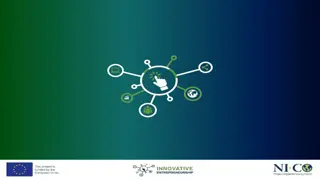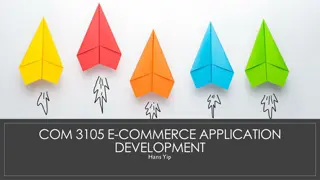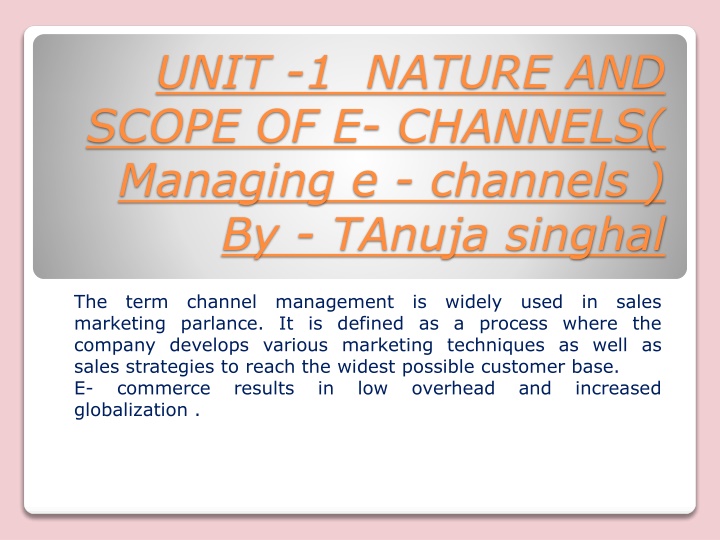
Understanding E-Commerce: Nature, Scope, and Importance
E-commerce is a vital aspect of modern business, encompassing various models like B2B, B2C, C2C, C2B, and more. Learn about managing e-channels, different types of channels, and the significant role of e-commerce in today's global market.
Download Presentation

Please find below an Image/Link to download the presentation.
The content on the website is provided AS IS for your information and personal use only. It may not be sold, licensed, or shared on other websites without obtaining consent from the author. If you encounter any issues during the download, it is possible that the publisher has removed the file from their server.
You are allowed to download the files provided on this website for personal or commercial use, subject to the condition that they are used lawfully. All files are the property of their respective owners.
The content on the website is provided AS IS for your information and personal use only. It may not be sold, licensed, or shared on other websites without obtaining consent from the author.
E N D
Presentation Transcript
UNIT -1 NATURE AND SCOPE OF E- CHANNELS( Managing e - channels ) By - TAnuja singhal The marketing parlance. It is defined as a process where the company develops various marketing techniques as well as sales strategies to reach the widest possible customer base. E- commerce results in low globalization . term channel management is widely used in sales overhead and increased
E- COMMERCE The E-commerce is the demand of time ,customers, business and nations. Now it will compulsion in a few years to use. But why this is happening and importance around the world? E-commerce is the online buying and selling process which is extremely important in our daily life now. The foremost reason behind the growth of internet users besides social media in e- commerce. E-commerce is at the heart of the internet and e- commerce is as important as a heart is for a body. how E-commerce is getting
DIFFERENT TYPES OF CHANNELS CHANNEL MANAGEMENT The term channel management is widely used in sales marketing parlance .It is defined as a process where the company develops various marketing techniques as well as sales strategies to teach the widest possible customer base .The channels are nothing but ways or outlets to market and sell products. The ultimate aim of any organisation is to develop a better relationship between the customer and the product. :PRODUCER WHOLESALER RETAILER END CONSUMER O
What are the different e commerce models? Business-to-Business (B2B) Business-to-Consumer (B2C) Consumer-to-Consumer (C2C) Consumer-to-Business (C2B) Business-to-Administration (B2A) Consumer-to-Administration (C2A)
E-commerce, or electric commerce, is the process of buying and selling of various products and services by businesses through the internet. Nowadays e-commerce has become very popular among the people who want to buy and sell different things because of the convenience it offers and the cost benefits to retailers and the cost savings to the customers, and also the secrecy it offers. 1. Business To Consumer (B2C) Business to consumer is the first type of e- commerce that is also the most common one. It is also known as B2C model. In this type online business selling is offered to individual customers. This type started to expand after 1995 and now became one of the most common e-commerce
2. Business To Business (B2B) Business to business, known as B2B model, is the largest e-commerce model that is based on revenue which involves trillions of dollars. In this both the buyers and sellers are business entities. B2B describes commerce transactions between businesses, such as between a manufacturer and a wholesaler, or between a wholesaler and a retailer. Benefits of B2B model: Encourage businesses online. Products import and export. Determine buyers and suppliers. Position trade guides.
3. Consumer To Consumer (C2C) Consumer to consumer (C2C) or citizen-to-citizen electronic commerce involves the electronically facilitated transactions between consumers through some third party. A common example is the online auction, in which a consumer posts an item for sale and other consumers bid to purchase it; the third party generally charges a flat fee or commission. 4. Peer To Peer (P2P) Peer to peer, peer-to-peer or usually said as P2P, is a communications model in which each party has the same capabilities and either party can initiate a communication session.
5. Mobile Commerce Mobile commerce or m-commerce, uses mobile devices like the mobile phones as can carry out online transactions. Nowadays, web designers are trying to optimize website so they can easily view on mobile phones and to allow the use of this model. Mobile Commerce conduct commerce using a mobile device, such as a mobile phone, a Personal Digital Assistant (PDA), a smartphone, or other emerging mobile equipment such as dashtop mobile devices. Other models Business to Administration (B2A) - encompasses all online transactions between companies and public administration. The model has increased due to governments investing in e-government. Consumer to Administration (C2A) - This model includes all electronic transactions conducted between individuals and public administration.






